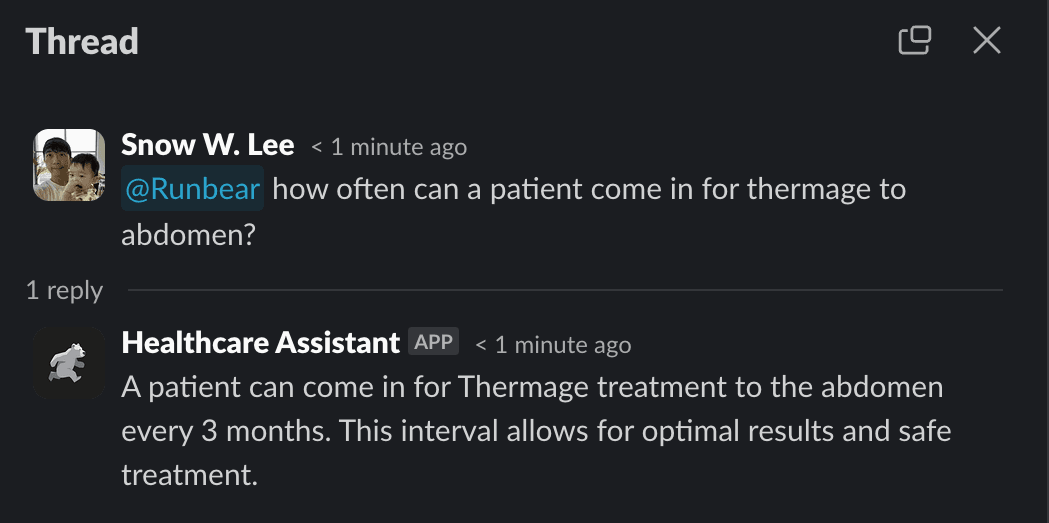Enhance Healthcare Services with AI-Powered Q&A in Your Workspace
Learn how healthcare professionals can enhance their research and client communications with AI-driven Q&A integrated into their workspace.
Healthcare professionals often face intricate and frequent questions related to patient care, medical protocols, and administrative tasks. Navigating these complexities swiftly and accurately is crucial for maintaining high standards of care.
By using Runbear to embed AI-driven Q&A systems into your team workspace, such as Slack or Microsoft Teams, you can seamlessly retrieve precise information from your customized knowledge bases. This integration accelerates response times to critical queries, reduces errors in information dissemination, and ensures that medical staff and patients receive timely and accurate information.
Ultimately, this technology not only improves patient care but also optimizes overall operational efficiency, fostering a more responsive and effective healthcare environment.
Benefits of AI Integration
- Faster Issue Resolution: AI can assist support teams in resolving issues more quickly by providing instant access to specialized knowledge.
- Cost Efficiency: By reducing the need for human intervention, AI lowers customer support costs, increases customer satisfaction, and boosts revenue.
With Runbear, this solution can be implemented without any coding or engineering support from your end, and the entire process takes just 20 minutes. Here's a step-by-step guide on how to achieve this.
1. Create a Specialized AI for Healthcare Support Team
The first step is to build an AI tailored to the needs of healthcare support teams. For instance, You can do this directly with Runbear, without having to navigate to OpenAI to do this.
Prompt Example:
This Assistant is designed to function as a healthcare customer support assistant. It should provide clear, empathetic, and accurate responses to users seeking assistance with healthcare-related inquiries. The assistant should offer information on medical services, appointment scheduling, insurance queries, and general health advice, while always emphasizing the importance of consulting a medical professional for any specific health concerns. It should avoid providing medical diagnoses or specific medical advice and instead guide users to appropriate resources or professionals. The assistant should be patient, respectful, and maintain confidentiality in all interactions. Responses should be based on the provided knowledge base whenever possible. The tone should be professional at all times. For urgent health-related queries, the assistant should advise users to call 911. The assistant should provide follow-up actions or resources after answering questions and should avoid asking for feedback at the end of interactions.
2. Train Your AI
Now, it's time to connect any relevant documents, data, or images to train your AI. In this example, this AI will be trained with all relevant healthcare knowledge, allowing it to handle inquiries that would typically require human expertise.
With Runbear, you connect documents stored in your Google Drive or Confluence. You can also upload files such as PDFs, Docs, and more.
3. Integrate the AI into the Channels Where Clients Ask Questions
Once your AI is trained, your next step is to integrate it into the communication channels used by your clients. With Runbear, you can integrate it into channels such as Slack, Microsoft Teams, Discord, Zendesk, HubSpot, and more. The goal is to ensure that support teams can easily access the AI to get immediate answers to their questions.
4. Customize Workflow
a) Mention @Runbear to get answers.
By default, support team members can ask questions to your AI by mentioning @Runbear, or your app’s name if you’ve already customized it.

b) Make your AI answer all the messages in the channel.
You can choose to have your AI respond to all the messages in a specific channel. This is useful when you have dedicated channels for questions.

Get Started Now
All set! Embrace AI integration with Runbear and experience the transformative benefits firsthand.